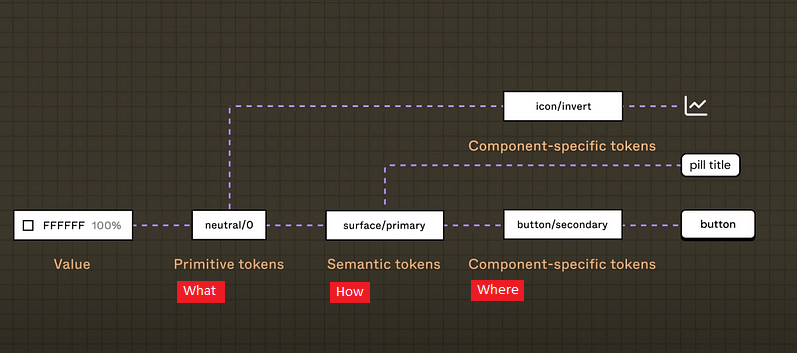The Importance of Naming Design Tokens for Clarity and Consistency
Keskeiset käsitteet
Effective design token names are crucial for clarity, consistency, and collaboration in design systems. The author emphasizes the significance of well-named tokens to enhance maintainability and efficiency.
Tiivistelmä
Naming design tokens is essential for maintaining a clear and consistent design system. Effective naming patterns include category-based, component-based, and modifier-based approaches. Descriptive, context-specific, brief, and consistent names are key principles to follow when naming design tokens. Choosing real words, starting with core tokens, and documenting the naming system are additional tips for selecting effective design token names. The case convention used in naming tokens also impacts readability and maintainability.
Naming design tokens: the art of clarity and consistency
Tilastot
Design tokens describe colors, typefaces, spacing, and other visual elements.
Effective design token names offer clarity, consistency, maintainability, and collaboration benefits.
Several typical naming patterns include category-based, component-based, and modifier-based approaches.
Key principles for naming design tokens include being descriptive, using context, keeping it brief, maintaining consistency, and considering scalability.
Tips for choosing design token names involve using real words, starting with core tokens first before expanding to specific ones.
Lainaukset
"Effective design token names offer several benefits: clarity, consistency, maintainability." - Zara Soltani
"Choosing real words for design token names is crucial for clarity." - Zara Soltani
"Maintain a consistent naming scheme throughout your design system." - Zara Soltani
Tärkeimmät oivallukset
by Zara Soltani klo uxdesign.cc 01-05-2024
https://uxdesign.cc/naming-design-tokens-347f630ba4f9
Syvällisempiä Kysymyksiä
How can the choice of case convention impact the readability of design token names?
The choice of case convention plays a significant role in determining the readability of design token names. Different case styles like PascalCase, camelCase, underscore_case, and kebab-case each have their pros and cons.
PascalCase: While easily readable for longer names and familiar to developers due to its common use in programming languages, it can appear visually heavy and blocky.
camelCase: Slightly less imposing than PascalCase and more common in design circles, but still may be perceived as technical by non-technical users.
underscore_case: Offers clear separation between words which aids readability for all audiences, but might look cluttered with longer names compared to other conventions.
kebab-case: Provides visual distinction from snake_case and is used in some design systems, yet it could be confused with URLs or file paths.
Ultimately, selecting a case convention that aligns with the team's preferences and understanding levels is crucial for ensuring that design tokens are easily comprehensible across both designers and developers.
What challenges might arise when trying to maintain consistency in naming across a large-scale design system?
Maintaining consistency in naming across a large-scale design system can present several challenges:
Scale: As the system grows with more components and tokens, keeping track of all naming conventions becomes increasingly complex.
Legacy Issues: Existing inconsistencies or poorly named tokens from earlier stages may need to be rectified without disrupting ongoing projects.
Team Alignment: Ensuring that all team members adhere to agreed-upon naming patterns requires continuous communication and education on best practices.
Evolutionary Changes: With updates or additions over time, maintaining consistency while accommodating new requirements poses a challenge.
Cross-team Collaboration: Different interpretations or implementations by designers versus developers can lead to discrepancies if not addressed promptly.
To overcome these challenges, establishing clear documentation outlining naming guidelines along with regular reviews and feedback sessions can help uphold consistency within a large-scale design system effectively.
How can effective collaboration between designers and developers enhance the process of naming design tokens?
Effective collaboration between designers and developers is essential for optimizing the process of naming design tokens:
Shared Understanding: By involving both teams early on in discussions about token names based on their respective needs (design aesthetics vs coding requirements), a shared understanding is fostered.
Feedback Loops: Regular feedback loops where designers provide input on how certain names reflect visual elements while developers assess practicality aid in refining token names collaboratively.
Consensus Building: Encouraging open dialogue ensures that decisions regarding token naming are made collectively rather than unilaterally by one group alone.
Alignment Meetings: Scheduled alignment meetings where both parties review existing tokens' names ensure they meet evolving project demands while adhering to established standards consistently.
5.Education & Training: Providing training sessions or resources on best practices around token-naming conventions helps bridge any knowledge gaps between designers' creative intent and developers' technical implementation capabilities.
By fostering strong collaboration between designers and developers throughout the entire process—from initial brainstorming sessions through final implementation—token-naming processes become more efficient, resulting in clearer communication channels within cross-functional teams working on designing systems efficiently together
0
